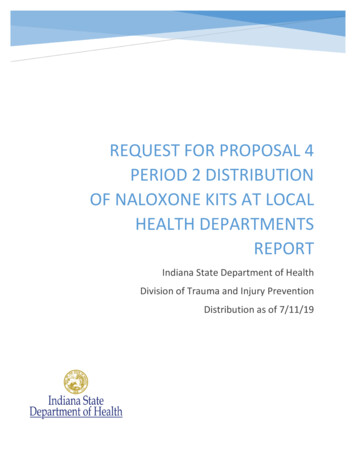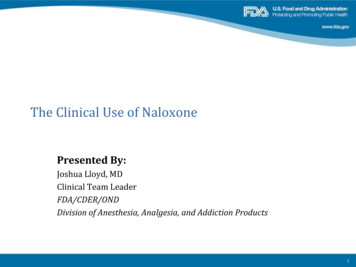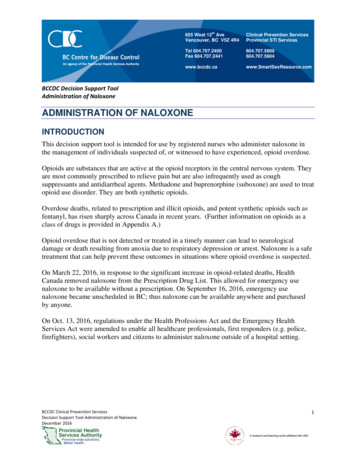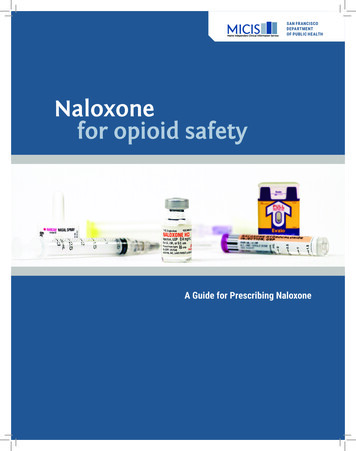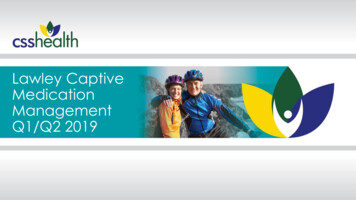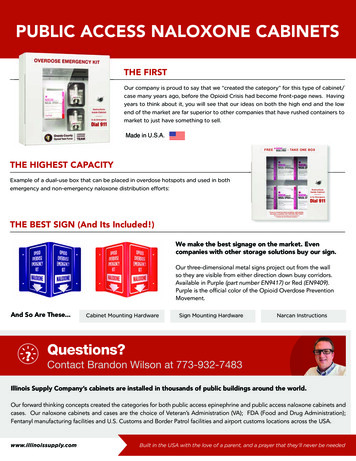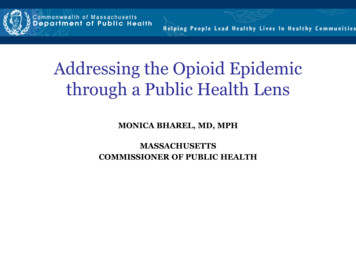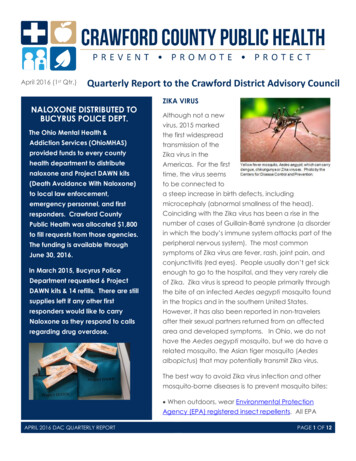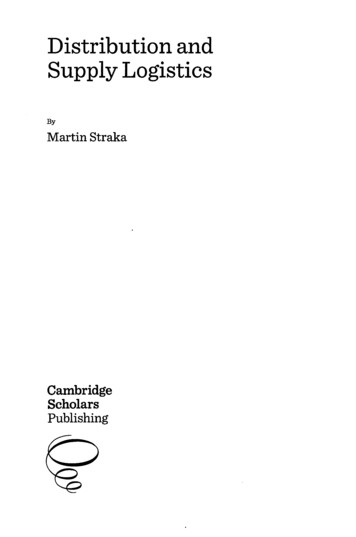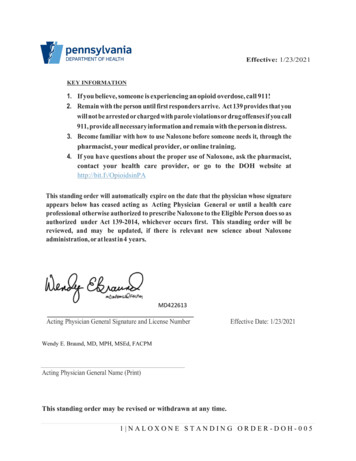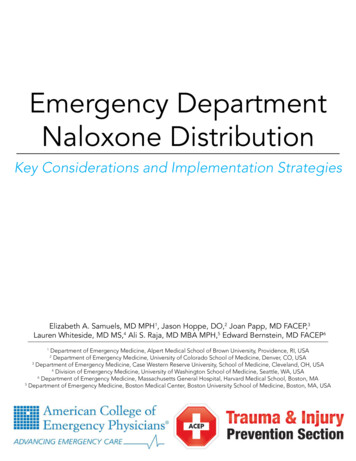
Transcription
Emergency DepartmentNaloxone DistributionKey Considerations and Implementation StrategiesElizabeth A. Samuels, MD MPH1, Jason Hoppe, DO,2 Joan Papp, MD FACEP,3Lauren Whiteside, MD MS,4 Ali S. Raja, MD MBA MPH,5 Edward Bernstein, MD FACEP6Department of Emergency Medicine, Alpert Medical School of Brown University, Providence, RI, USADepartment of Emergency Medicine, University of Colorado School of Medicine, Denver, CO, USA3Department of Emergency Medicine, Case Western Reserve University, School of Medicine, Cleveland, OH, USA4Division of Emergency Medicine, University of Washington School of Medicine, Seattle, WA, USA6Department of Emergency Medicine, Massachusetts General Hospital, Harvard Medical School, Boston, MA5Department of Emergency Medicine, Boston Medical Center, Boston University School of Medicine, Boston, MA, USA12
IntroductionOpioid overdose deaths have quadrupled since 1990,1 and are now a leading cause of injury and death in theUnited States, killing more people between 25 to 64 years old than motor vehicle accidents.1 Most overdosedeaths occur in the pre-hospital setting and 78% are unintentional. 2 In the last few years, there have been multiplefederal recommendations to increase availability of naloxone, 3,4,5 an opioid antagonist and overdose reversalagent, to prevent out of hospital opioid overdose deaths. Naloxone has been distributed from community overdoseeducation and naloxone distribution (OEND) programs since 1996. These programs have been shown to decreasefatal opioid overdose rates, 6,7 and many states have implemented policies to improve naloxone access. 8,9,10 In thelast several years, some Emergency Departments (EDs) have started ED OEND programs to provide naloxone topatients identified at risk for opioid overdose (Figure 1). 11,12Given the high prevalence of unmet substance abuse needs among ED patients, 13 and increasing frequencyof drug related ED visits,14 emergency physicians have an opportunity to prevent opioid overdose deaths. EDnaloxone distribution is a simple and cost effective way to provide a lifesaving intervention to patients at risk foropioid overdose. 15,16 While there are many ways to develop an ED program, tailored to your local and institutionalneeds, there are several key topics every ED OEND intervention must consider for successful implementation:1) Program Implementation and Utilization: Is there support for ED OEND at your institution? Whatare barriers and facilitators for patients and providers?2) Policies and Regulations: What are the hospital, insurance, pharmacy, state, and federal regulations?3) Cost: How much does it cost and what are the methods of reimbursement?4) Means of Distribution: In what form and by what means will you provide patients with naloxone?5) Patient Education: What resources do you have to improve education and use?Figure 1: National heroin and opioid overdose deaths, 1999-2013.Data Source: National Center on Health Statistics, CDC WONDER1
Program Implementation & UtilizationEstablishing a program doesnot guarantee utilization. Hospital,provider and patient factors need to beoptimized to ensure adequate programuptake. Primary factors influencingprogram utilization include knowledgeof research evidence; local, and statepolicies and laws; ED/hospital support,policies, and procedures; professionalorganizations’ policies and guidelines;and cost and payment mechanisms.To successfully implement aprogram, you need a champion tocoordinate program implementation.Gaining support from your hospital andED leadership early in the process willhelp facilitate the development of policyand procedures easily incorporated intodaily ED operations. If you are unsurewhether providers would be willingto utilize an OEND program, you canperform a pre-program assessment and,if necessary, education. Minimizingthe labor required by physicians andnurses can diminish provider utilizationbarriers and garner support. Forexample, rather than creating a separatesystem or additional step to provide analoxone rescue kit (NRK), incorporateorders into your Electronic MedicalRecord System (if you have one). Thishelps integrate the program into usualemergency care (See Figure 2 for anexample of how an order can appearin Epic). The policy should be simple,straightforward, and easy to understand.Roles, responsibilities, and expectationsfor naloxone provision and educationshould be clearly defined. Prior toprogram launch, provide education toproviders, nurses, nursing assistants,secretaries, and any other relevant EDstaff about the program policies andprocedures. Provider and staff educationcan be done at departmental meetings,EM residency conferences, or nursingroll call/change of shift meetings. Havethe policy easily accessible for referencewhere other ED policies are kept. It canalso be circulated by email or posted inthe department.Patientbarriersto receiving a NRKincludestigma,mistrust of medicalproviders, fear oflegal consequencesfor possession or use,and fear of feelingunpleasant feelingsof withdrawal afterreceiving naloxone.Additionally,patients are oftenunaccompaniedbysomeone who could Figure 2: Example Epic order setuse the NRK to savethem in case of an overdose. Building recommend that naloxone be providedpatient trust and rapport will improve to patients taking more than 100mgprogram acceptability. Soliciting patient morphine equivalents daily, have knownfeedback about your program will also opioid abuse/dependency, or who havehelp improve program quality.had an opioid overdose (Significant riskProminent provider barriers include factors for opioid overdose are listed innegative attitudes toward patients Figure 3). When you start your program,presenting with addiction(s) or after start with a discrete patient populationan overdose, misinformation or lack of that is easy to identify as being at riskknowledge about naloxone, and lack for future overdose, such as individualsof clarity about which patients should who present after an opioid overdose.receive naloxone. Previously, naloxone Staff training, program monitoring, anddistribution programs focused on staff feedback should be data driven andheroin users, however with the rise of provided on a regular, ongoing basis.prescription opioid use and overdose, weFigure 3: Persons at risk for opioid overdose1) Received emergency care for opioid intoxication or poisoning2) Have suspected substance abuse or non-medical opioid use3) Are taking 100mg morphine equivalents/day4) Are receiving an opioid prescription for pain and:a) Are prescribed methadone or buprenorphine.c) Have poorly controlled respiratory disease or infection.d) Have renal dysfunction, hepatic disease, cardiac illnesse) Have known or suspected excessive alcohol use ordependencyf) Concurrent use of a benzodiazepine or other sedativeg) Suspected poorly controlled depression5) Patients in above categories with difficulty accessing emergencymedical services.6) Recent incarceration/release from prison with history of opioid use.7) Resumption of opioid use after period of abstinence.2
Policies and RegulationsThe largest barrier to naloxone availability is fact that naloxone has not been approved for over-the-counter(OTC) sales. Multiple state policies have been used to address this barrier. The Food and Drug Administration(FDA) last considered the issue in 2012 and concluded that more data is necessary before moving forward. WhileOTC naloxone is still a possibility, it would require a well-organized and funded citizen petition or, more likely,a drug company to take it on. Both options are limited by costs and/or anticipated financial return on investment.Regulatory issues specific to naloxoneThere is significant variability between states.17 Legal clarity regarding state level protection may encourageprescribing and have wide impact on naloxone availability. While existing18 laws may be perceived as a barrierto naloxone program implementation, thirty-seven states have successfully amended these regulations and ablueprint exists to help other states wanting to explore this option.19Common regulatory barriers limiting Naloxone availabilityAccess to naloxone is the main barrier faced by patients and programs. As mentioned earlier, its status as aprescription drug (but not a controlled substance) means that a prescriber is necessary. Often providers willing toprescribe are in short supply. Most state practice laws require a treatment relationship between the prescriber andthe provider which limits the impact of those providers willing to prescribe. State EMS laws also define the levelof first responder who may access naloxone and restrictive policies for carting naloxone may disproportionatelyaffect some areas.20Liability, real or perceived, associated with naloxone is an issue for prescribers, pharmacists, and bystanders.Prescribers may be concerned with any activity that can be perceived as outside the practice of medicine orstandard of care in their area. Pharmacists have concerns about their liability for providing medications withouta specific prescription and storing/providing prefilled injection medications. Bystanders may not use naloxoneand/or call 911 for overdoses because of perceived criminal liability due to drug possession, syringes, outstandingwarrants or parole violations.Potential regulatory solutions:1) Third party prescribing: This statutory change specifically endorses the prescribing of naloxone to oneindividual with intent for the drug to be administered to another at-risk individual e.g., a family member,roommate or friend. The idea being that victims are unable to administer to themselves and the medicationis better suited to be carried by a family member or friend likely to be with the victim. This is currentlyavailable in 33 states.22 Most laws include limited liability protection for all parties involved.2) Standing naloxone orders: Standing orders outline a formalized hospital, system or statewide processallowing for naloxone to be distributed to an individual without a prescription. The standing order is notpatient specific, and the patient may not be known to the prescriber, so the patient needs only to meetcriteria to receive the medication from the pharmacist e.g., vaccinations and emergency contraception.Again limited immunity is provided for persons acting in good faith. Typically there is one prescriber forthe entire program. This approach is currently available in 24 states. 22a. There are other alternatives to standing orders that may be helpful in some states or situations wherethey can be amended for this purpose.i. Collaborative practice agreements: These delegate medical management to pharmacists forcertain predefined conditions. e.g., Medication Therapy Management (MTM) programs. Someversion exists in 48 states.ii. Pharmacist as prescriber: Here the medication is provided and the physician is informed later.Pharmacists may need to maintain additional certification. Some version exists in 8 states.3
Policies and Regulations (continued)3) Good Samaritan Laws: These laws, also known as medical amnesty policies or 911 laws, provide limitedcriminal immunity for the victim and the caller. The intent is to send the message that keeping peoplealive is more important than punishing them. As such, the immunity needs to be comprehensive enoughto change behavior and implemented in a way that police officers and opioid users are both aware. Theselaws exist in 23 states. 224) EMS/First Responder Access: The scope of practice needs to be modified so that naloxone use isapproved in all levels of responder rather than just advanced responders.18,23 This would help decreasetime to naloxone rescue, particularly in areas with limited numbers of advanced level responders.Figure 4: States with Third Party Prescribing (top) and Good Samaritan (bottom) legislationhighlighted in yellow. Available at: http://lawatlas.org/query?dataset good-samaritan-overdose-laws4
Cost5Cost can be a significant barrier for many patients Amphastar. This rebate has been available only toand EDs. The two main considerations when planning programs providing naloxone for overdose preventionthe budget for your program are the cost of the naloxone and not for general hospital use.and other kit items and the time the healthcare workerDepending on your state Medicaid program, it mayspends educating the patient to use the kit.be possible for you to bill the patient’s insurance forIn the early planning stages, you should explore the naloxone kit and the education provided to thea variety of sources to fund your program. Hospital patient. It is vital that you work with a state Medicaidor departmental funding, health department program representative to develop a process to do this. Manygrants and city orstate Medicaid programs will provide coverage forcounty funds maynaloxone and it may be as simple as adding it toBilling in the EDbe available.Ityour state’s outpatient formulary. The next step isis important toto identify an expert in your hospital in ED billingis divided into twoidentify key alliesand coding. Billing for the naloxone kits as well asfundamentallyin these areas whofor the education that is provided to the patient cancan support you indifferent categories: improve the sustainability of your program. Billingthis effort. Your EDin the ED is divided into two fundamentally differentProfessionalserviceChairman, hospitalcategories: Professional service and facilities.24leadership, healthProfessional service codes are determined based onand facilities.commissioners,the “complexity and intensity of provider performedmedical examinerswork and include the cognitive effort expended by theor coroners, community based naloxone distribution provider.” 24 The facility or technical coding guidelinesprograms, syringe exchange programs and even law reflect the “volume and intensity of resources utilizedenforcement can advocate for you in this effort. Your by the facility to provide patient care.” 24 Unlikelocal health departments may already have an opioid professional service billing, the Centers for Medicaidtask force or other resources in place to tackle the and Medicare Services (CMS) does not have anyepidemic from other angles and they may be eligible standard guidelines for facility level coding. 24,25 CMSfor grants that can be utilized for your project.even allows hospitalsIf your community has already established ato write their own rulesDepending on yournaloxone distribution program it would befor facility billing asbeneficial to work with them, as they may belong as they are appliedstate Medicaidaware of local sources of available funding.consistently. 24,25 Toprogram, it mayYour county medical examiner or coronerbe reimbursed for thecan provide compelling data on opioidnaloxone kits, you mustbe possible for youoverdose mortality, which can supportbill the facility rathertobillthepatient’srequests for funding. The criminal justicethan a professionalsystem is another resource that is not oftencode.insurance for theconsidered when looking for healthcareIf you want tonaloxonekitandthefunding. Local police departments, jails,distribute the Evzio drug courts, your state Attorney General andeducation provided to auto-injector, Kaléo, thethe United States Attorney’s office are oftencompany that producesthe patient.tasked with providing services to opioid users.Evzio , has someDrug seizure funds are routinely distributed todonationcommunitypolice department budgets for drug preventionservice programs withefforts and may be available to assist your program. hospitals, community and government organizations.In Massachusetts, New York and Ohio, State Attorney There are also special insurance reimbursement andGenerals have been able to negotiate a six dollar rebate rebate programs. Most insurance plans, includingon each vial of naloxone with the naloxone manufacturer government insurance plans, will cover Evzio ,
Cost (continued)however some insurance companies will require priorauthorization. 26 Low income, uninsured patientswho do not qualify for Medicare or Medicaid, may beeligible to receive Evzio at no cost through the KaléoCares Patient Assistance Program.27The last stage of planning your Emergency Departmentnaloxone program involves ordering and assemblingyour naloxone kits. Items that may be included in thekit include educational materials, pamphlets or DVDs;nasal atomizers or needle and syringes depending onroute of administration, gloves, face shield for rescuebreathing and two doses of naloxone. A sample budgetis outlined in Table 1.Naloxone is currently available from three differentmanufacturers: Amphastar, Hospira and Kaléo. TheAmphastar product, a prefilled syringe containing twomilligrams of naloxone in a concentration of 2 mg/2mL,is the recommended concentration for intranasaladministration. The average cost for a single (2 mg)nasally administered dose of the AmphaStar product is 33. Next, Hospira manufactures a single dose vial,which is available in the recommended concentrationof 0.4/mg for intramuscular administration. Theaverage cost for a single dose (0.4 mg) of the Hospiraintramuscular naloxone is 15.83. Your hospital may beeligible for a cost discount, check with you pharmacist.Finally, Kaléo manufactures an auto-injector device,which includes two (0.4 mg each) doses of intramuscularnaloxone. This product costs 287.50 per dose, but thecost is significantly reduced if covered by insuranceor provided through Kaléo’s cost assistance program.The FDA has accepted new drug applications for twopre-assembled nasal products by the pharmaceuticalcompanies Adapt Pharma28 and Indivior PLC. 29 Theseproducts may become available commercially in thecoming year.The initial purchase of items for your kits shouldbe made only after closely evaluating your patientpopulation to estimate the number of at risk patientsseen in your Emergency Department. This will helpyou purchase an appropriate quantity of materials andnaloxone. It is advisable to purchase naloxone on anas needed basis as it has a shelf life of only 2 years.If too much medication is purchased initially, valuablefunding may be wasted when the drug reaches itsexpiration date.Table 1: Sample BudgetItemLuer-Jet Prefilled Syringe - Naloxone 2mg/2 ml vial 28.50 /vial (2 vials per kit- 57/kit)Cost Estimate 57NDC NUMBER 76329-3369-1 http://www.amphastar.com/images/Naloxone.pdfLMA MAD Nasal , Nasal Atomizers (2 per kit)http://www.lmana.com/pwpcontrol.php?pwpID 6359DVDs (with cases)Teal, Nylon CHECK WALLET bag 7"W X /zipper-check-wallet-bags.htm 6.50 1.25 1.19Quick Reference Guide 0.38Laerdal Face Shield – eld 1.64Brochures 0.256
Means of DistributionProviders can provide patients naloxone by direct to patient distribution, writing a prescription, referral toa community organization, or referral to a pharmacy participating in a Collaborative Practice Agreement (seeRegulatory section for more information).FormulationsCurrently, naloxone is offered in intramuscular (IM) andintranasal (IN) formulations. It is recommended that you prescribetwo doses of whichever formulation you choose. IM formulationscan be delivered in the lateral arm or thigh. Intranasal (IN)naloxone has similar efficacy and safety as IM naloxone forreducing overdose and is given as a spray in each nostril. 30,31IM naloxone can also be dispensed as a two single-dose vials,0.4mg/mL, with a 3cc syringe and 1 inch 23G needle (Image 1).Evzio (Image 2) is an FDA approved pre-filled auto-injectorthat contains a single dose of Naloxone 0.4 mg,32 prescribedin packs of two auto-injectors. IN naloxone is prescribed as a Image 1: Harm Reduction Coalition’s SKOOP:2mL, prefilled luer-lock needless syringe with an IN mucosal Skills and Knowledge on Overdose Prevention IMatomizing device (Image 3). 33naloxone rescue kit with two doses IM naloxone0.4mg/mL, syringe, needle, and barrier for rescuePrescription Writingbreathing.An easy way to implement take-home naloxone within anyEmergency Department is to write a prescription and providepatients at risk for overdose with written instructions. There are a variety of existing resources available that canbe tailored to patients at risk for heroin overdose or at risk for prescription opioid overdose.How to DistributeNaloxone distribution programs can vary based on available resources, as well as hospital, pharmacy, city, andstate policies and regulations. Providing a prescription and written overdose education instructions is low-impactto the health system and can be implemented immediately. However, there can be barriers associated with patientstaking the prescription to pharmacy including pharmacy availability and patient out-of-pocket costs. Providing apatient with naloxone and overdose education as a ‘kit’ can eliminate these barriers. Kits can be assembled in thepharmacy and either sent to the ED or stored in an ED automated medication management system to be retrievedby nurses after a prescription is written by a physician. Some EDs utilize a standing order policy, where all kitsare prescribed by a physician’s standing order and can be dispensed at discretion of the nurse, social worker, or adrug counselor.7Image 2: Evzio autoinjector andtrainerImage 3: Intranasal naloxone 2mg/2mLneedlelesss syringe and MAD.
Patient EducationPatient education should contain information about example, can consult a community Recovery Coach (RC)overdose risk factors, how to avoid an opioid overdose, who is trained, certified, and employed by a communityhow to recognize and respond to an overdose, and how recovery organization. The HPAs and RCs both provideto administer naloxone. A combination of in-person overdose education and naloxone training in addition tocounseling and an educational video or handout is referral to addiction treatment, but consultation of thebest, although not always feasible. Family and friends community RCs allows for in person training withoutshould be included in the trainingadditional cost to the hospital. This haswhenever possible, as they will likely beallowed for OEND implementationA combinationadministering naloxone to your patient inat community hospitals in addition toof in-personan out of hospital overdose.academic centers.In person education can be providedcounseling and a If in-person education is not feasible,by anyone in the ED: social workers,there are multiple video and handoutvideoorhandoutdrug counselors, nurses, pharmacists,resources available for use. Videos canor physicians. The advantages of inbe shown on hospital televisions or aeducationalperson education are that it is interactive,computer on wheels. Handouts can bematerials is best, included in the naloxone kit. Video andquestions can be answered in real time,can be tailored to each patient, and canhandout materials are cheaper, portable,although notbe combined with referral to treatment.uniform, and can be referenced byThe primary barriers to implementationalways feasible. patients at home. However they are alsoare time required by providers and costless personal, less engaging, and use offor service provision. If you choose tohandouts alone misses and opportunity forutilize an overdose educator who can spend at least fifteen referral to addiction treatment. PrescribetoPrevent.org hasminutes providing education, you can bill for this service a selection of educational videos, handouts, and onlineby documentation of Screening, Brief Intervention and training modules tailored to different patient populations.Referral to Therapy (SBIRT). SBIRT is an evidence- Images 4 and 5 are stills from one of the availablebased approach used to deliver early intervention and educational videos, “Staying Alive on the Outside.” Ontreatment to individuals with problematic use, abuse and the following page is an example educational handout thatdependence on alcohol and illicit drugs. To bill for this is distributed from Lifespan affiliate EDs in Rhode Island.service, a healthcare professional must spend a minimum PrescribetoPrevent.org has several examples of patientof 15 minute of face-to-face time with the patient and educational materials you can use. Of note, Evzio document a screening tool such as the DAST-10, the drug provides audible instructions for how to administerabuse-screening test. In some centers, such as Boston naloxone, making it incredibly easy to use, even forMedical Center, this is provided by hospital employed people who have no prior training.Health Promotion Advocates (HPAs).Check with your hospital, but your educational materialsUse of out of hospital resources can help minimize may need to be approved by your hospital Pharmacy andthe time and cost barriers. Hospitals in Rhode Island, for Therapeutics Committee.Images 4 and 5: Still shots from “Staying Alive On the Outside”8
How to Avoid OverdoseRisk Factors for Overdose Only take medicine prescribed to you Call a doctor if your pain gets worse. Do not take moremedicine than instructed Never mix pain medicine (opioids) with alcohol or sleeping pills Dispose of unused medications safely Store your medicine in a secure place Learn how to use naloxone Teach family and friends to recognize and respond to anoverdose Mixing pain medicine (opioids) withalcohol, benzodiazepines, or otherdrugs Lower tolerance due to a period ofnot using opioids or drugs (aftertime in jail, a hospital, detox, ordrug-free treatment) Using drugs by yourselfAdapted from: prescribetoprevent.org, harmreduction.org, ‘Get the SKOOP’ overdose prevention brochure9Lifespan Pharmacy & Therapeutics Committee approved June 2014
ConclusionThe first steps to setting up anOEND program is to understandthe local policies and regulationsabout standing orders, third partyprescribing, collaborative practiceagreements,GoodSamaritanlaws, and provider medicationdistribution. This will determine theoptions you have for distribution,whether it be giving naloxonedirectly to a patient or providingpatients with a prescription orreferral to a local pharmacy orcommunity organization. If policiesallow for direct to patient naloxonedistribution, cost considerationsmay affect what formulation youdecide to use and the components ofyour kit. Naloxone and SBIRT arebillable to the insurance, but stateand local departments of health,grants, and hospital funding, shouldalso be considered as potentialsources of funding. There are awide range of educational materialsavailable for both providers andpatients.PrescribetoPrevent.orghas a repository of materials youcan use. If your hospital does nothave the capacity to provide in-person overdose education andnaloxone training, there may belocal community organizations youcan partner with. Finally, whenmaking policies and procedures foryour program, make them simple,incorporated into usual emergencycare, have clear goals, roles andexpectations, and define your patientpopulation. Patients and providerswill need continuous education andshould have an avenue to providefeedback for program qualityimprovement.Citations1.2.3.4.National Center on Health andStatistics, CDC Wonder; Warner M,Chen LH, Makuc DM, Anderson RN,Miniño AM. Drug poisoning deathsin the United States, 1980–2008.National Center for Health Statistics.Data brief, no 81. Hyattsville, MD:National Center for Health Statistics.November 2011.CDCP. Drug Overdose in the UnitedStates: Fact Sheet. Accessed March29, 2014 at ose/facts.html; CDCP. Wide-rangingOnLine Data for Epidemiologic Research (WONDER) [online]. (2012)Available from URL: http://wonder.cdc.gov/mortsql.html.Szalavita M. Preventing Overdose:Obama Administration Drug CzarCalls for Wider Access to Overdose Antidote. Time Magazine.Aug 22, 2012. Available at: ider-access-to-overdose-antidote/. AccessedOctober 20, 2015.Attorney General Holder AnnouncesPlans for Federal Law EnforcementPersonnel to Begin Carrying Naloxone. July 31 2014. Available at: t-personnel-begin-carrying Accessed October 20,2015.Mufson S, Zezima K. Obama announces new steps to combat heroin,prescription drug abuse. WashingtonPost. October 21 2015. Available 89faf561dc story.htmlAccessed October 23, 2015.Walley AY, Xuan Z, Hackman HH, etal. Opioid overdose rates and implementation of overdose educationand nasal naloxone distribution inMassachusetts: Interrupted time seriesanalysis. BMJ 2013;346:f174.Albert S, Brason FW, 2nd, SanfordCK, et al. Project Lazarus: Community-based overdose prevention in ruralNorth Carolina. Pain Med 2011;12Suppl 2:S77-85.Davis CS, Ruiz S, Glynn P, et al.Expanded access to naloxone amongfirefighters, police officers, andemergency medical technicians inMassachusetts. Am J Public Health2014;104:e7-9.9.10.11.12.13.Kim D, Irwin K, Khoshnood K. Expanded Access to Naloxone: Optionsfor Critical Response to the Epidemicof Opioid Overdose Mortality. Am JPublic Health. 2009;99(3):402-407.Department of Justice Office of PublicAffairs. Attorney General Holder,Calling Rise in Heroin Overdoses‘Urgent Public Health Crisis,’ VowsMix of Enforcement, Treatment.Available at: alth-crisis-vows-mix. AccessedApril 1, 2015.Dwyer K, Walley AY, Langlois BK,et al. Opioid education and nasalnaloxone rescue kits in the emergency department. West J Emerg Med2015;16:381-384.Samuels E. Emergency departmentnaloxone distribution: A Rhode Islanddepartment of health, recovery community,
Emergency Department Naloxone Distribution Key Considerations and Implementation Strategies Elizabeth A. Samuels, MD MPH1, Jason Hoppe, DO,2 Joan Papp, MD FACEP,3 Lauren Whiteside, MD MS,4 Ali S. Raja, MD MBA MPH,5 Edward Bernstein, MD FACEP6 1 Department of Emergency Medicine, Alpert Medical School of Brown University, Providence, RI, USA 2 Department of Emergency Medicine, University of .
